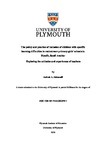The policy and practice of inclusion of children with specific learning difficulties in mainstream primary girls’ schools in Riyadh, Saudi Arabia: Exploring the attitudes and experiences of teachers
| dc.contributor.supervisor | Quinn, Jocey | |
| dc.contributor.author | Alshenaifi, Amirah | |
| dc.contributor.other | Plymouth Institute of Education | en_US |
| dc.date.accessioned | 2018-09-06T08:47:13Z | |
| dc.date.available | 2018-09-06T08:47:13Z | |
| dc.date.issued | 2018 | |
| dc.identifier | 10257323 | en_US |
| dc.identifier.uri | http://hdl.handle.net/10026.1/12231 | |
| dc.description.abstract |
This research project examines the implementation of the policy and practice of inclusion in girls’ primary schools of Saudi Arabia. In particular, it focuses on the work of teachers - their attitudes, beliefs, methods, and experiences - because it is they who are ultimately responsible for applying the policy by using inclusive practices in their classroom activities. Since the 1970s many countries have adopted a policy of including in mainstream schools those children with physical or cognitive impairments, or with learning difficulties. Formerly, children with special needs or learning difficulties were segregated in ‘special’ schools; this process of separation caused the children and their families to feel shame and humiliation, and it often led to the children to suffer lower standards of learning. After much discussion and review of the issue, commencing in the 1970s the policy of inclusion was developed and accepted in most developed nations; this was a recognition of the inequity of segregation, an acknowledgement of the human rights of all children, and an acceptance of the need for children to enjoy the benefits of a full education within the context of the wider society This thesis traces the development of the policy and its implementation in primary schools for girls in the city of Riyadh, Saudi Arabia. To research the topic I recruited 423 female teachers from 50 schools from across the metropolitan area. Of the participants, 214 were ‘specialist’ teachers: that is, they specialised in working with children who have special needs or learning difficulties. The other 209 were teachers who worked in ‘mainstream’ classes – classes which contained both non-impaired children and special-needs children. The project consisted of a quantitative survey in the form of a questionnaire, and a qualitative component in the form of semi-structures interviews with 23 of the teachers. A central conclusion from this enquiry is that inclusion has not yet been achieved. Girls with physical or cognitive impairments are being integrated into mainstream classes – but full inclusion has not yet been accomplished. There are several possible explanations for this: first, the policy is relatively new and so many mainstream teachers have had limited experience of working with special-needs children. Second, the policy and its implications IV are not fully comprehended by all teachers. Third, the training of teachers has not always been adequate. A fourth explanation concerns the practicalities of including children who may exhibit a very wide range of impairments. It is apparent that there is a disjunction between the philosophy and the implementation of inclusion. That is, the principle and policy are noble and desirable, the philosophy of inclusion being endorsed by teachers, but in practice it is very difficult to implement. | en_US |
| dc.language.iso | en | |
| dc.publisher | University of Plymouth | |
| dc.subject.classification | PhD | en_US |
| dc.title | The policy and practice of inclusion of children with specific learning difficulties in mainstream primary girls’ schools in Riyadh, Saudi Arabia: Exploring the attitudes and experiences of teachers | en_US |
| dc.type | Thesis | |
| plymouth.version | publishable | en_US |
| dc.identifier.doi | http://dx.doi.org/10.24382/583 | |
| dc.identifier.doi | http://dx.doi.org/10.24382/583 | |
| dc.rights.embargoperiod | No embargo | en_US |
| dc.type.qualification | Doctorate | en_US |
| rioxxterms.version | NA |
Files in this item
This item appears in the following Collection(s)
-
01 Research Theses Main Collection
Research Theses Main


